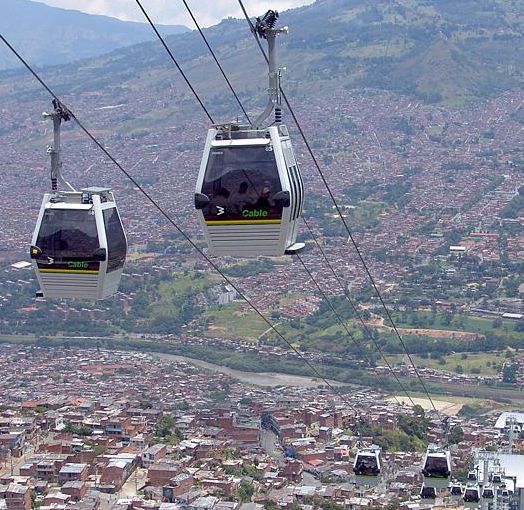During a recent conversation I had with Oboi Reed from the mobility justice nonprofit Equiticity about the racial and economic equity issues identified by new reports on Chicago’s traffic camera program, Reed discussed programs from Colombia with the goal of promoting public safety and/or reducing traffic violence through non-punative measures. Here’s a look at one of those initiatives by Streetsblog Chicago co-editor Courtney Cobbs. – John Greenfield, Streetsblog Chicago co-editor
I’ve seen the Build Better Act, a federal Congressional reconciliation bill that includes provisions related to climate change and social policy, called an opportunity to invest in human infrastructure. While the bill’s chances of being passed look slim, it doesn’t stop me from thinking about the ways in which the government can invest in people by making changes to the built environment. An illustration of that concept is a 2012 research project conducted in Medellín, Colombia examining the impact of the built environment on violence reduction and fostering societal trust.
For the study, “Reducing Violence by Transforming Neighborhoods: A Natural Experiment in Medellín, Colombia,” the researchers looked at neighborhood-level differences that seemed to impact the health of residents. They compared residential demographics and statistics such as the homicide rate and assaults, as well as collective efficacy (belief in residents’ ability to care for one another and the neighborhood) and trust in the criminal justice system in a neighborhood that received infrastructure improvements and one that did not.
In 1999, Medellín enacted a territorial plan to promote urbanism and regulate development, which included a cable-propelled transit system (gondola) known as Metrocable to provide better transportation access to communities on the city’s steep hills. The first line open in 2004, connecting an elevated train system in the city center to the impoverished Santo Domingo neighborhood. The municipal government made other infrastructure improvements and increased services to communities served by the gondola, including additional lighting for public spaces; new pedestrian bridges and street paths; “library parks” (combining a library building parkland); new buildings for schools, recreational centers, and centers to promote microenterprises; more police patrols; and a family police station (focusing on the protection of women and children) next to a gondola station.
Researchers found that between 2003 (before the aforementioned improvements) and 2012 (after) levels of homicide and perceived violence declined both for residents living in the neighborhood with Metrocable stations and associated amenities (called the “intervention” group, and people who lived in other communities that did not get these upgrades (the “control” group.) But the drop was steeper in the gondola neighborhoods, where the homicide rate dropped by 84 percent compared to 60 percent in the control group.
Belief that residents could have a positive impact on reducing crime, and look out for one another in their neighborhood, increased in the intervention group but stayed stable for the control group. For example, the proportion of intervention group respondents reporting that their neighbors would intervene to break up a fight among children increased from 65 to 81 percent, while the corresponding proportion in the control group remained about the same. Trust in the criminal justice system and reliance on the police for help also increased more dramatically in the intervention group.
(As someone who can imagine a world without police, I wonder what structures we will form to replace police. My hope is that these structures are more trusted than the police and provide real safety to everyone within a community.)
The researchers warn that their results should not be used as a basis for specific types of interventions. They state that their intent “was to study with a large scale investment and neighborhood infrastructure can be linked to measurable changes in violent activity, not to identify what types of investments are likely to have the most payoff.”
However, the study authors stand behind the idea that “by improving public spaces and creating new institutions, the intervention(s) provided more opportunity for neighbors to interact, develop trust, and become willing to intervene when the social order was threatened.” To me, that is the most important takeaway from the report: Opportunities to interact with one’s neighbors can create more trust and will to intervene whenever someone is at risk of being harmed.
The city of Chicago would do well to create inviting, engaging, and inclusive public spaces across the city. I would advocate for greater people-centered investments in communities of color on the South and West sides, which have seen decades of disinvestment. I am not under the illusion that walking, biking, and transit investments alone will be enough to reduce crime and encourage care and concern among neighbors. Whatever investments are made, they shouldn’t be dictated by city officials, but instead be decided upon by local residents.





